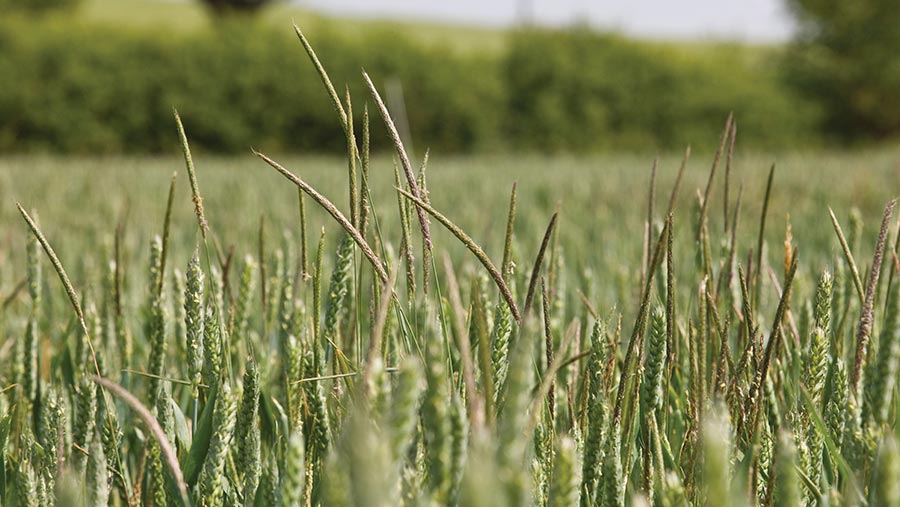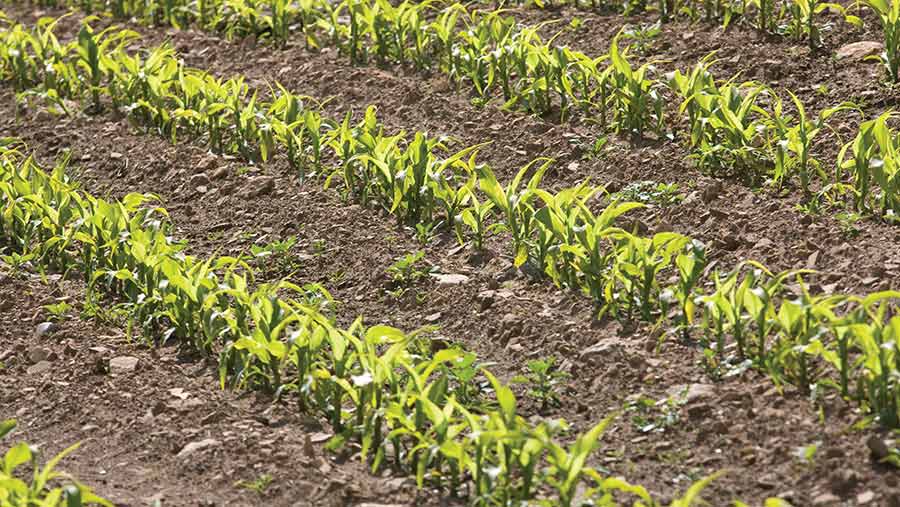Crop Watch: Plan for cleaner wheats and grassweed control
 Blackgrass in wheat © Tim Scrivener
Blackgrass in wheat © Tim Scrivener The dry weather has put a dampener on the spread of septoria in winter wheats, but after this season’s high septoria pressure, growers are being urged to look at varieties with better disease resistance for next season.
Grassweeds are a common sight, largely due to early drilling and very dry autumn conditions last year, which saw many pre-emergence herbicides not working to their best effect without the help of some soil moisture.
See also: Wheat variety choices to help reduce risk this autumn
The recent dry weather is causing signs of drought stress in some light land crops and hampering maize establishment, with those maize crops lucky enough to catch the recent rain storms likely to be the best placed to thrive.
East
Ben Pledger
Farmacy (Bedfordshire/Hertfordshire)
The majority of crops are now on the home straight to harvest. Sugar beet has had its weed control, and monitoring for aphids is still ongoing, although there is a distinct lack of them being found in crops at the time of writing.
Attention is now turning to planning for the autumn drilling campaign before harvest starts, so that we have at least an outline plan of our direction of travel. In doing this, we’re still being reminded of last autumn’s dry weather.
The lack of rainfall prior to the majority of cereal drilling saw flushes of blackgrass and bromes appear as the cereal crops emerged.
Dry soils reduced the potency of residual herbicides and we are now seeing high plant populations of blackgrass in places.
Fast forward to the wet spring we’ve just experienced, and septoria control was difficult without using very robust rates of fungicides containing mefentrifluconazole or fenpicoxamid.
With crop prices considerably lower now than they were this time last year, input costs need scrutinising.
Delaying drilling this autumn will reduce blackgrass pressure in crops, and also reduce septoria pressure in the spring, which in turn will reduce the potential for needing to use higher rates of fungicide, keeping input costs down.
Blackgrass patches will now be mapped prior to harvest. Variable-rate drilling maps can then be generated, increasing seed rates in these areas to increase crop competition against the weed.
Varietal selection should also be looked at prior to drilling this autumn. There have been several wheat varieties starting to show big weaknesses to septoria this spring.
These varieties have seen an extra fungicide spend of up to £60/ha over and above that of the cleaner varieties on the AHDB Recommended List.
The cost of buying new seed of a cleaner variety can outweigh the potential extra fungicide spend on home-saving existing on-farm varieties with lower disease resistance.
North
David Martindale
Arable Alliance (Yorkshire)
A month of dry weather has been in complete contrast to such a wet spring, with long spells of sunshine ideal for grain filling.
The dry conditions have also been hugely beneficial in reducing disease pressure, most notably septoria in wheat, yet damaging by causing drought stress.
Crops on lighter soil types are really struggling and the rain on Sunday evening may not have arrived in time to keep these crops going.
It seems grassweeds of various types are thriving this year. Driving around the countryside, there seems to be more blackgrass than ever
before. Perhaps more worrying is the appearance of various brome species, which seem to have come from nowhere in fields that have never had them before.
Rogueing low infestations is crucial to prevent further spread of these grassweeds.
Septoria pressure in winter wheat has eased due to a month without rain. Early-sown crops of varieties susceptible to this disease have the highest infection levels.
Shoot density is a factor in septoria development, yet rarely has it shown such large differences as this year.
For a given variety on the same farm where crops are thicker, there is significantly more septoria.
The loss of chlorothalonil and the more limited eradicant activity of the best current fungicides compared with previous products highlights the need to select varieties with good septoria resistance.
T3 fungicides have recently been applied to protect against fusarium, while also keeping on top of yellow rust, which has rapidly increased in the past few weeks. Brown rust could also become an issue due to the recent hot weather.
Early-sown spring barley crops look particularly well, with optimal shoot numbers and clean canopies.
Late April-sown crops on heavier land are struggling now and look more likely to disappoint than surprise in terms of yield.
Panicles on spring oats are emerging and they look as resilient as ever in the dry conditions. Their ability for prolific rooting has helped them scavenge enough water and nutrients even when they were sown late.
Spring beans are a mixed bag of crops. February-sown fields have plants that are chest high and look full of promise, while April-sown crops are coming into flower below knee height on some soil types.
Thankfully, the dry weather has helped to ease what was once ferocious chocolate spot pressure, as well as downy mildew.
Black bean aphids are starting to build, with dense colonies forming at the top of bean plants. T2 fungicides are currently being applied to spring beans to protect the new growth from chocolate spot and bean rust.
With harvest not far away, planning is under way for next season’s cropping and variety choices.
The economic landscape looks somewhat different to the financial bonanza from harvest 2022, with margins looking tight at current commodity price levels.
West
Neil Potts
Matford Arable (Devon)

Young maize plants © Tim Scrivener
Since last writing the season has done a complete U-turn. Back in May at the time of my last contribution we had had approximately 10 days with no rain and it was beginning to cause problems.
Since then we have had no rain and it has now created havoc with the spring cropping.
Crops that went in the ground before the last appreciable rainfall (about 75mm in two days) are now sitting in severely capped soils, which is never good for any crop.
Those that were planted after this rain have flown out of the ground, but are losing moisture too quickly if rain does not fall imminently.
The winter crops have thus far been immune to the dry hot conditions and arguably the wheat crops have greatly benefited as the weather has dried up what was rampant septoria in many crops.
On thin and light soils however, things are now changing rapidly and winter crops that a week ago were looking really good are now beginning to succumb to drought stress, with premature senescence occurring in many fields.
At the current rate of progress I can see many winter barley crops being ready in early July.
As it is a major crop for us in the South West, there are some serious concerns over what will happen to the maize crop.
If we see rain before the 8-leaf stage we should get our “get out of jail free card”, but if the maize remains stressed through the 8- to 10-leaf stage then we can expect to see missing grain sites and poor cob development.
With a bigger than usual crop in the ground and on-farm forage stocks at low levels, it is imperative that the maize crop performs well, but for that to happen we are going to need to have significant rainfall.
The other problem at present is many maize crops are getting close to the latest growth stage for herbicide applications, but with the lack of rain only a fraction of the expected weed burden has so far emerged. In short, headaches all round.
The common theme running through this report is that the most important input for all crops at present is rain. There are showers forecast for the next few days.
Let’s just hope that they come and turn into more general rain, rather than sporadic thunderstorms.
South
Tod Hunnisett
AICC (Sussex)
On Sunday (18 June) we had our first measurable rain at home since the Coronation. It measured 1.2mm. Less than 10 miles from us they had 18mm.
Last weekend, west Isle of Wight had 22mm, East Wight had nothing. And the Isle of Wight is less than 23 miles wide.
The Friday before the Coronation I got my vehicle stuck because I reversed off the tarmac track to turn round, having looked at a field of spring beans that had just gone in under appalling (but first opportunity) conditions.
The said spring beans are now struggling in concrete, and on my last visit the temperature was 30C. Does anyone have a phone number to Mother Nature to help me with agronomy decisions please?
Barley has turned, oats are turning, winter oilseed rape is changing colour and some wheats are telling us it’s coming to the end of the season.
Funny how the canopy is so even with all this so-called barley yellow dwarf virus around.
It will be interesting to see fungicide trials results this year – could depend on whether they were on East Wight or West Wight.
Strangely enough, disease control has been one of the last things that have woken me up in a cold sweat in the night – plenty else has taken its place.
The two words I’ve heard most this season are “price” (ie of wheat) and “cost” (ie of inputs).
The third most repeated word is “wind” (ie North-easterly force 4 and above). Once again, I applaud the operators for managing to get stuff done.
Other often-repeated words are “yellow leaves” and “cold” and then “stiflingly hot”.
I look forward to words like “England have won the Ashes” and “Would you like another beer, Tod?” Both are conversations I would most welcome.

